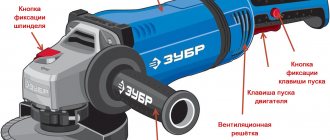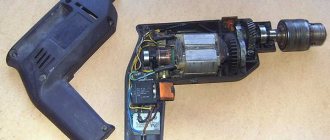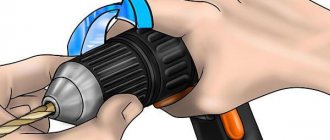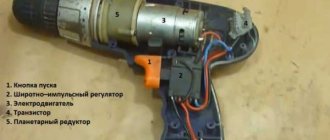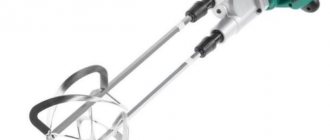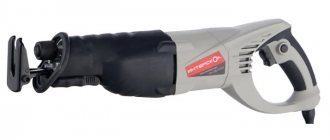How to make a speed controller Bulgarians on their own
If you have an old angle grinder in your arsenal, do not rush to write it off. Using a lightweight electronic circuit, the device can be easily upgraded by adding a speed configuration function. Thanks to a conventional regulator, which can be assembled in a home-made environment within a few hours, the functionality of the device will increase significantly. By reducing the rotation speed, the grinder can be used as a grinding and sharpening machine for different types of materials. New capabilities are emerging for the introduction of additional attachments and accessories.
Why does an angle grinder need low revs?
The integrated disc speed control function allows you to delicately process materials such as plastic or wood. At low speeds, operating comfort and safety increases. This function is especially useful in electrical and radio installation practice, in car services and restoration workshops.
Today, among professional users of power tools, there is a strong worldview that the simpler the device is, the more reliable it is. And it is better to take the additional service stuffing outside the unit. In this situation, equipment repair is greatly simplified. That’s why some companies specially produce remote, separate electrical regulators that connect to the machine’s power cord.
Speed controller and soft start - for what purpose are they necessary?
Modern grinders use two fundamental functions that increase the reliability and safety of the tool:
- speed controller - a device designed to configure the number of engine revolutions in different operating modes;
- soft start - a scheme that ensures a slow increase in engine speed from zero to maximum when the device is turned on.
They are used in electromechanical tools, the design of which uses a commutator motor. Helps reduce wear on the mechanical part of the unit during switching on. They reduce the load on the electronic elements of the mechanism, launching them into operation evenly.
As studies of material parameters have shown, more intense production of friction units occurs at the time of a sharp transition from a state of rest to a mode of high-spirited movement. For example, one start of a gasoline engine in a car is equivalent to 700 km of wear on the piston group.
When the power is turned on, an abrupt transition occurs from a state of rest to rotation of the disk with a movement of 3.5.5–10 thousand rpm. Those who have worked with an angle grinder understand perfectly well the feeling that the machine simply “rips out of your hands.” At this moment, the overwhelming number of breakdowns associated with the mechanical part of the unit occur.
The stator and rotor windings also experience the least load. The commutator motor starts working in short-circuit mode, the electromotive force is already pushing the shaft forward, but inertia does not yet allow it to spin. A jump in starting current appears in the electric motor coils. Of course, they are structurally designed for such work; a moment comes (for example, during a power surge in the network) when the winding insulation cannot withstand and an interturn short circuit occurs.
When we include soft start circuits and motor speed configurations in the electronic circuit of the tool, our client is left with the above difficulties that automatically disappear. Apart from everything else, the problem of the “dip” of voltage in the general network at the moment of starting the hand tool is solved. This means that the refrigerator, TV or computer will not be subject to the threat of “burnout”. And the safety circuit breakers on the meter will not operate and cut off the current in the house or apartment.
The soft start circuit is used in angle grinders of the middle and highest price categories, the speed control unit is used to a greater extent in professional models of angle grinders.
Adjusting the speed allows you to process soft materials with an angle grinder, do narrow grinding and polishing - at high speed the wood or paint will simply burn.
Additional electrical circuits increase the price of the tool, but increase the service life and level of safety during operation.
Smooth start and rotation speed adjustment + (Video)
Smooth starting of a power tool is the main guarantee of its longevity. Remember when a light bulb burns out? Most often at the moment of switching on. Because after connecting to the electrical network, the load increases sharply. The damaged parts of the spiral cannot withstand it and it burns out.
The same processes occur in the grinder. At the moment of switching on, the current increases sharply, because the driving forces need to not only move the armature, but also quickly gain the required speed. The effect of such a hard start can be the most deplorable - winding breakage.
To reduce the likelihood of tool failure due to a hard start, it is necessary to modify the angle grinder and equip it with a small built-in soft start device.
Another modification is the rotation regulator. From personal experience, everyone knows how inconvenient it is to work with a tool that does not have rotation adjustment. If an electric drill does not have such a device, then it is difficult to select the rotation speed and feed of the drill. This leads to either jamming of the drill or its breakage.
A lathe works similarly, in which there is a whole set of special gears to adjust the rotation of the spindle. Not only the safety of the cutter, but also the quality of material processing largely depends on this.
You can combine two advantages - soft start and adjustment of shaft speed using an electronic circuit. It is quite possible to assemble it yourself and install it directly into the car body. With such a circuit, it will start smoothly without creating overloads in the windings and network. And with the same scheme, it will be possible to regulate the speed in order to select the mode of operation with any material.
If you cut metal with significant thickness and hardness, then it is necessary to maintain high speeds. But when processing surfaces of low-melting materials, high speed will do more harm than good. It needs to be reduced. It is dangerous to work with stone or tiles at high speed. And here it needs to be reduced.
Even when grinding the disk, the rotation speed must be proportionally changed, because the linear speed of the disk edge will decrease. You cannot do without a speed controller when working with a diamond-cut disk, because at high temperatures it is destroyed very quickly.
Everything suggests that if the grinder does not have a speed controller, then one must be made and installed in the car.
Circuit operation
Trimmer resistor VR1 changes the charging time of capacitor C1. When voltage is applied to the circuit, at the 1st moment of time (1st half-cycle of the input sinusoid), triacs DB3 and TRIAC are closed. The output voltage is zero. Capacitor C1 charges, the voltage here increases. At a certain point in time, specified by the R1-VR1 chain, the voltage on the capacitor exceeds the opening threshold of the triac DB3, and the triac opens. The voltage from the capacitor is transmitted to the control electrode of the TRIAC triac, which also opens. Current begins to flow through the open triac. At the beginning of the second half-cycle of the sinusoid, the triacs are locked until capacitor C1 is recharged in the reverse direction. Thus, at the output there is a pulse signal of a complex shape, the amplitude of which depends on the operating time of the C1-VR1-R1 circuit.
Installing a homemade board
Ready-made installation recipes are unacceptable. Those who decide to equip an angle grinder with a regulator arrange it in accordance with their goals for the tool model. Some people insert the device into the handle of the holder, others into a special additional box on the case.
In different models, the place inside the grinder body may be different. There is quite a bit of free space for installing a control unit. In others, you have to bring it to the surface and strengthen it using another method. But the trick is the fact that, usually, there is always a certain cavity at the back of the instrument. It is designed for air circulation and cooling.
This is usually where the factory speed controller is located. Of course, place the diagram you made yourself in this place. To prevent the regulator from burning out, thyristors should be installed on the radiator.
Typical speed controller circuit
This is what the assembled speed controller board looks like
The engine speed controller is not just a variable resistor that lowers the voltage. Electronic control of the current strength is necessary, otherwise, as the speed drops, the power and, accordingly, the torque will decrease proportionally. In the end, a critically low voltage value will occur when, even with the slightest resistance of the disk, the electric motor simply cannot turn the shaft. Therefore, even the simplest regulator must be calculated and implemented in the form of a well-developed circuit.
Read also: Patterns for an electric jigsaw on wood
And more advanced (and therefore expensive) models are equipped with regulators based on an integrated circuit.
Integrated controller circuit. (the most advanced option)
If we consider the electrical circuit of the angle grinder in principle, it consists of a speed controller and a soft start module. Power tools equipped with advanced electronic systems are significantly more expensive than their simpler counterparts. Therefore, not every home craftsman is able to purchase such a model. And without these electronic units, all that remains is the electric motor winding and the power button.
The reliability of modern electronic components of angle grinders exceeds the service life of motor windings, so you should not be afraid of purchasing a power tool equipped with such devices. The only limiting factor can be the price of the product. Moreover, users of inexpensive models without a regulator sooner or later come to install it themselves. The block can be purchased ready-made or made independently.
Features of installation of the finished block
When purchasing and installing an industrial regulator inside an angle grinder, in most cases you have to modify the body - cut a hole in it to allow the adjustment wheel to come out. However, this may adversely affect the rigidity of the casing. Therefore, it is preferable to install the device outside.
The numbers on the adjustment wheel indicate the number of spindle revolutions. This value is not absolute, but conditional. “1” is low speed, “9” is high speed. Other numbers serve as a guide for adjustments. The placement of the wheel on the body varies. For example, on the Bosch PWS 1300–125 CE, Wortex AG 1213–1 E or Watt WWS-900 angle grinders, it is located at the base of the handle. On other models, such as the Makita 9565 CVL, the adjustment wheel is located at the end of the housing.
The scheme for connecting the regulator to the angle grinder is not simple, but from time to time it is not always easy to stretch the cables to the button, which is located at the other end of the device body. The problem can be solved by selecting a rational cross-section of the wire or bringing it to the surface of the casing.
A good option is to install the regulator on a different device attached to the network cable. Rarely does everything work out on the first try; when you do, you have to test the device and then make some adjustments. This is easier to do when access to its elements is open.
Fundamentally! If you do not have experience with electrical circuits, it is more advisable to purchase a ready-made factory regulator, or angle grinder, equipped with this function.
Device Operation Management
The basic rule when operating an angle grinder with a homemade speed controller is to adhere to the work and rest schedule. It is known that an engine running at a “regulated” voltage in particular gets very hot. When grinding at low speeds, it is important to take frequent breaks so that the commutator windings do not burn out.
It is also highly not recommended to turn on the tool if the speed regulator is set at cinema level - the reduced voltage will not be enough to rotate the rotor, the collector lamellas will remain operating in short-circuit mode, and the windings will begin to overheat. Unscrew the variable resistor to the maximum, then, turning on the angle grinder, reduce the speed to a suitable value.
Following the correct order of activation and adjustment will allow you to operate the angle grinder indefinitely for more than one year.
Today, you should be aware that adjusting the speed of rotation on an angle grinder occurs following the principle of a water tap. The device does not increase the number of revolutions, it can only decrease them. Hence the conclusion is that if the highest rated speed is 3000 rpm, then when connecting the speed controller, the grinder
operates in a spectrum lower than the highest speed.
Attention! If the angle grinder already contains electrical circuits inside itself, for example, it is already equipped with a speed regulator, then the thyristor regulator will not work. The internal circuits of the device simply will not turn on.
The intricacies of working an angle grinder with a homemade regulator
DIY speed controller for angle grinders
A limitation in the operation of the modified instrument will be strict adherence to the “work/rest” mode. This is necessary to preserve the collector winding. When operating at low speeds, the brushed motor gets very hot and can cause trouble.
The next factor is the moment of switching on. The speed must be reduced when the tool is running. When turned on at minimum speed, the voltage may not be enough to spin the rotor, the commutator lamellas will remain closed, and the winding will begin to overheat and may burn out.
It should be understood that installing a regulator will not increase the power of the tool in any way. If the specification indicates a maximum number of 3000 rpm, then the angle grinder will produce a range from 0 to 3000 rpm.
Video on the topic: Speed control for an angle grinder
Publications on the topic
Options for making a router from a grinder with your own hands
Popular models of angle grinders with soft start and speed control
Do-it-yourself motor cultivator - instructions and manufacturing tips

